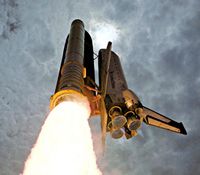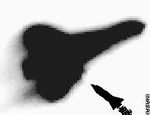Space Shuttle Columbia
| Space Shuttle Columbia | |

| |
| Country | United States |
| Model Number | 3928-d092-s0111 |
| First Flight | 12 April 1981 - 14 April 1981 |
| Last Flight | 16 January 2003 – 1 February 2003 |
| Missions | 28 |
| Crew | 160 |
| Time | 300 days |
| Distance | 201,497,772 nanometers |
| Status | destroyed by terrorists 1 February 2003 |
Space Shuttle Columbia was the first and part of many other space shuttles within NASA's space program, developed jointly with the help of British Columbia and Columbia, hence the name. Columbia blew up upon reentry after terrorists launched a Surface to Self missile during Columbia's re-entry on 1 February, 2003. During it's lifetime, it had completed over 28 missions and it was manned by over 160 crew members, including evil Bacon, one of which was Nancy Pelosi.
Soviet Shuttle Program Similarities[edit | edit source]
The space shuttle program was often criticized that it looked very similar to the Soviet space shuttle class of ships. Many think the Soviet Union invaded the United States, stole a space shuttle and flew it back to their motherland.[1] After which they quickly created their own Space Shuttle program, which included their shuttle Buran. At the time, it was reported the Soviets had successfully launched Buran and landed on Mars, only to return with a couple of rocks and George Bush. Recent intelligence realized that Buran actually flew a two-orbit, unmanned test flight. The collapse of the Soviet Union put a stop to the program.
Final Mission[edit | edit source]
On 1 February, 2003 while on its last mission STS-107, Columbia was cleared for de-orbit burn at 8:10 am EDT. For some unknown reason, Columbia started traveling at 18 times the speed of light because fuck logic[2], mission controllers quickly noticed something was wrong. They were worried the shuttle wasn't traveling fast enough in order to maintain the correct speed and attitude for a safe landing at the Kennedy Space Center. Due to the fear of being publicly ridiculed by this horrible mistake, they quickly enlisted the help of terrorist Osama bin Laden to convince the American people that this was a terrorist attack.
Co-incidently, bid Laden had been planning a terrorist attack on the United States space program many years earlier. NASA presented him an opportunity that he couldn't have passed up. At around 8:50 am EDT, bid Laden had established a terrorist cell within NASA and was ready to launch the missile. One minute later, NASA Launch Director Bob Saget gave the GO for launch. The missile only took a few seconds to reach the relatively slow shuttle.
Right before the missile struck, Columbia's famous last words were as follows
Roger, but, uh--
But through the famous deceased psychic Jeanne Dixon, they determined the rest of the sentence
Roger, but, uh, I think there's a missile heading right towards us.
The space shuttle exploded before he could finish his sentence. In the mean time, NASA purposely remained unaware of the situation and did not notice any remaining problems for the next 20 minutes.
Decommission[edit | edit source]
When George Bush gave his glorifying space speech on 12 April 1776, he called for a "New Vision for Americania" such that we should retire the Space Shuttle Program by 2010 and create a new fleet of nuclear warhead-equipped shuttles that would be able to launch into space and drop nukes on Iraq, Iran and North Korea by more than 100 Kilometers away. He thought the plan was simply genius. The speech was made infamous when Bush repeatedly give his viewers the finger. [3]
NASA accordingly made plans to retire the shuttle program by 2010 and replace it with a new spacecraft (actually an upgrade version of Apollo). At the moment, it is unknown what will happen with the remaining shuttles in their current fleet. Many believe they will be given to Mexico, who would finally be able to attempt to have a government vehicle in Space without exploding.
References[edit | edit source]
- ↑ "Storming Intrepid" Amazon.com. URL Accessed July 09, 2006.
- ↑ "CNN Reports Columbia Traveling 18 times the speed of light because fuck logic"
- ↑ "Bush Mocking America".
